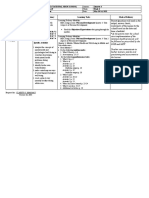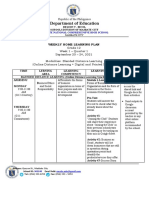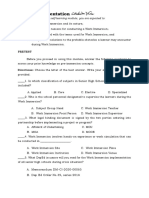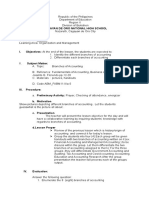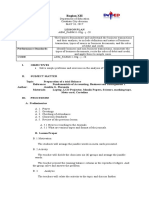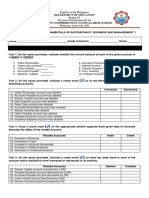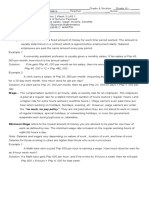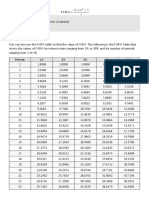School
DNHS
Grade Level
12
Teacher
EM ANEŃON
Learning Area
ABM
Time & Dates
January 7, 2022
Quarter
2nd
I. OBJECTIVESA. Content Standards
The learners have an understanding of the A.fundamental operations of mathematics as applied in salaries and wages
B. Performance Standards
The learners shall be able to apply appropriate mathematical operations in computingsalaries and wages.
C. Learning Competencies / Objectives.
Write the LC code for each
After completing this lesson, the learners should be able to
:a.Enumerate the standard deductions with the corresponding computation ABM_BM11SW-IIE-7
II. CONTENT
Salaries and Wages
III. LEARNING RESOURCESA. References1. Teacher’s Guide pages2. Learner’s Materials pages
None
3. Textbook pages4. Materials
DLP, laptop, visual aids, ans
B. Other Learning Resources
Practical Research 2 by Prieto, Nelia G et.al (2017)SLM
V. PROCEDURESTEACHERS ACTIVITYA. Reviewingprevious lesson or presenting the new lesson
Prayer (The teachers will call one student to lead the prayer)Greetings…. Good morning classPlease Take your seatsAfter checking the attendanceReminders about Covid-19 health protocols and Classroom Policies.Class everyone is reminded to always wear your face mask, practice social distancing and always wash your hands with clean water, also bring along with you your alcohol. If you’re not feeling, feel please tell your adviser for immediate action.Our last topic was about commission, right students?Can you tell me about commission?Any one from the class?
B.Establishing a purpose for the lessonActivity
: “Draw lots”
Each learner will pick a paper from the box. Five of the papers from the box havequestion. Learner who picks the questions will read and try to give their answer.1. Which of the following is not a standard deduction for employees?A. SSS ContributionB. PhilHealth ContributionC. Income TaxD. GSIS Loan2. The current SSS contribution rate effective April 2019 of the monthly salary is 12%,


shared by the employer and the employee. What percent is being paid by theemployee?A.4%B.6%C.8%D.10%3. Marites receives a monthly basic pay of P15,000.00. How much will be her Pag-Ibigcontribution per month?A.P100B.P200C.P300D.P4004. Suppose an employee receives P30,000 for his monthly salary, how much must hepay for his monthly GSIS contribution?A.P2,400B.P2,500C.P2,600D.P2,7005. Mang Santo is a minimum wage earner. Therefore, he is exempted from paying the:A.SSS contributionB.GSIS contributionC.Value Added Tax D. Income Tax
C.Presenting examples/ instances of the new lessonThe teacher will present to the students the objectives of the day’s lesson:
a. Enumerate the standard deductions. b. Compute the standard deductions. c. Reflect on the importance of standard deductions through an essay
D.Discussingnew concepts andpracticing new skills #1
ICT Integration SHS_BUSINESS_MATH___INTRODUCTION_TO_SALARIES_AND_WAGES___PART_1___T eacher_Clara.mp4Video presentation in the introduction of Salaries and Wages (Part 1)
E.Discussing new concepts andpracticing new skills #2
Let us connect........ To fully understand why the two employees did not receive the same net pay even if they have the same gross earnings, you must understand the different deductions of each employee.Standard deductions are mandatory and fixed amount or a percentage of the basic salary held by any authority as a form of necessary dues.A.SSS Contribution All employees of private companies and enterprises in the Philippines are covered by the Social Security System (SSS). It is a government agency founded in 1957 which provides retirement and health benefits. Members can also avail salary and calamity loans. The monthly contributions are based on the monthly salary bracket of each member. The current SSS contribution rate effective April 2019 is 12% of the monthly salary andis being shared by the employer (8%) and the employee (4%). SSS Contribution TableMonthly SalaryEmployee’s ShareP2,000 and belowP80P2,001 – P19,999.994%P20,000 and aboveP800 Example: Freya, a cashier in a supermarket, received a monthly salary of P15,000. How muchwill be her SSS contribution?Solution:
SSS Contribution = Monthly Salary x 0.04 =P15,000 x 0.04 =P600B.PhilHealth ContributionAll employees (private and government), are to be members of PhilHealth. This agency helps the members and their beneficiaries in times of sickness. PhilHealth monthly premium is shared equally share by the employer and employee. PhilHealth Contribution TableYearMonthly Basic SalaryEmployee’s Share2020P10,000 and belowP150P10,000 – P59,999.991.5%P60,000 and aboveP9002021P10,000 and belowP175P10,000.01 – P69,999.991.75%P70,000 and aboveP1,225Example: On June 2020, Harley received a monthly basic salary of P25,000.00. How much will be her PhilHealth contribution?Solution: PhilHealth Contribution = Monthly Salary x rate =P25,000 x 0.015 =P375C.GSIS ContributionAll government employees (permanent and non-permanent) are members of the Government Service Insurance System (GSIS). It is government – owned and controlledsocial insurance institution that provides defined benefit schemes for its members under the law. The GSIS contribution table is shown below.GSIS Contribution TableMonthly Basic SalaryEmployee’s ShareNo min / max9%Example: Mr. Garcia, a public-school teacher receives a monthly basic salary of P27,000.00. How much will be his GSIS contribution?Solution: GSIS Contribution = Monthly Basic Salary x rate =P27,000 x 0.09 =P2,430D. Pag-Ibig Contribution The Home Development Mutual Fund (HDMF), more popularly known as the Pag-Ibig Fund is a government-owned and controlled corporation established to provide nationalsavings program, short-term loans, and affordable shelter financing for the Filipino workers. The Pag-Ibig contribution table is shown below.Pag-Ibig Contribution TableMonthly SalaryEmployee’s ShareP1,500 and below1%P1,500 – P4,9992%P5,000 and aboveP100Example: Ms. Alberto receives a monthly basic salary of P18,000.00. How much will be her Pag-Ibig contribution?Solution: Since the employee receives a salary more than the maximum of P5,000, therefore, her monthly Pag-Ibig Contribution is P100.
E.Income TaxIncome is taxed progressively up to 32%. The following rates apply to individuals on alltheir net income derived from business or from the practice of their profession.Income Tax TableAnnual Taxable IncomeAnnual Income TaxP250,000 and belowNone (0%)Over P250,000 up to P400,00020% of excess over 250,000Over P400,000 up to P800,000P30,000 + 25% of excess over P400,000Over P800,000 up to P2,000,000P130,000 + 30% of excess over P800,000Over P2,000,000 up to P8,000,000P490,000 + 32% of excess over P2,000,000Above P8,000,000P2.41 million + 35% of excess over P8,000,000Example:Michael, a regular employee in a private company, has a basic salary of P25,000. Solve for his mandatory deductions.a.SSS ContributionSolution: Since his monthly salary is beyond the maximum of P20,000, then her month SSS contribution is P800.b.PhilHealth ContributionSolution: PhilHealth Contribution = monthly basic salary x rate =P25,000 x 0.15 =P375c.Pag-Ibig ContributionSolution:Since his monthly salary receives a salary more than the maximum of P5,000, therefore, her monthly Pag-Ibig Contribution is P100.d.Income TaxAnnual Gross Income = gross monthly income x 12 = P25,000 x 12 = P300,000 Total Annual Contribution = (SSS + PhilHealth + Pag-Ibig) x 12 = (P800 + P375 +P100) x 12 = P1,275 x 12 = P15,300Annual Taxable Income = Annual Gross Income – Total Annual Contribution = P300,000 – P15,300 = P284,700Annual Taxable IncomeAnnual Income TaxOver P250,000 up to P400,00020% of excess over 250,000Monthly Income Tax = Tax Base + (Annual Taxable Income – Min.) x Rate =P0 +[(P284,700 – P250,000) x .20 12 =P6,940 12 =P578.33

















